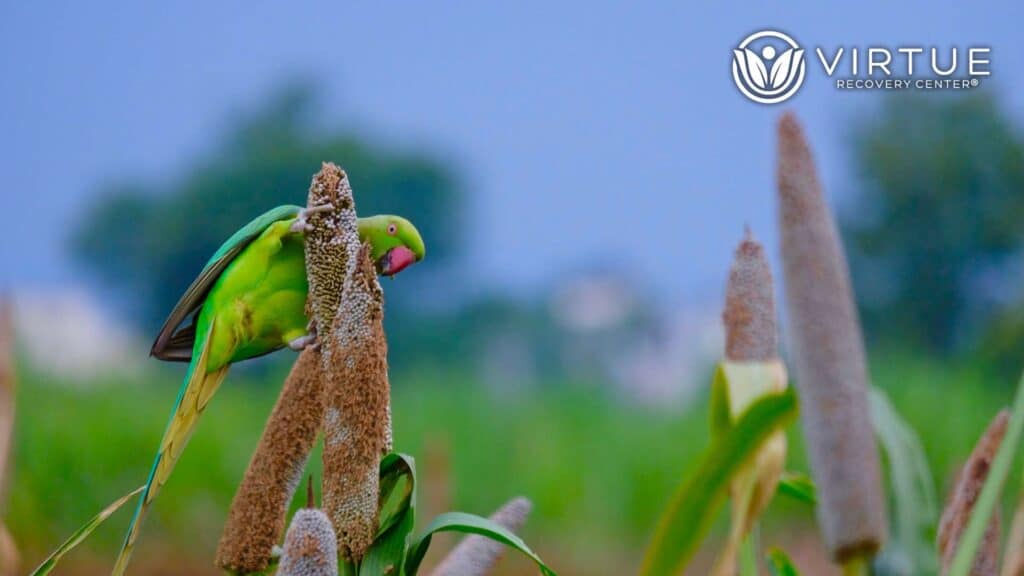
Table of Contents
Key Takeaways
-
Parrots in India have been observed raiding poppy farms, feeding repeatedly on opium pods.
-
These birds show behavior that closely resembles substance dependence or addiction.
-
Their actions highlight how narcotics impact the brain and behavior, even in animals.
-
Understanding these patterns helps us better grasp human addiction and the need for compassionate care.
-
Virtue Recovery Center provides expert, non-judgmental treatment for those struggling with opioid and substance use disorders.
Introduction
Imagine this: A field of bright poppy flowers in the heart of India, quietly growing in the sun.
Suddenly, flocks of parrots swoop in, tearing into the poppy pods, feasting on the opium inside, and then flying away—only to return again and again.
This isn’t fiction. It’s a real situation unfolding in parts of central India, especially in the Neemuch district of Madhya Pradesh. Licensed poppy farmers are reporting that parrots have become addicted to the morphine-rich latex inside the plants.
While the story may seem strange or even amusing at first, it reveals something serious about addiction and human behavior. The repeated, obsessive actions of these birds offer a mirror to the struggles many people face with substance use.
Let’s take a closer look.
What’s Happening in India’s Poppy Fields?
In certain areas of India, especially Madhya Pradesh and Rajasthan, farmers grow poppies under government license for medical and pharmaceutical purposes. The poppy flower produces a pod that contains a latex rich in morphine, used to make opium.
But now, large groups of parrots have discovered these fields. And they’re not just pecking casually—they’re acting like determined raiders.
-
Some parrots visit the fields 30 to 40 times a day, according to reports.
-
They cut open the poppy pods, sip the latex, and even fly away with whole pods.
-
After the narcotic effects wear off, they return for more.
-
Farmers have reported seeing birds crash into trees or fly in a daze, suggesting they are under the influence.
Despite attempts to scare them off with firecrackers, loudspeakers, and even guards, nothing has worked. The birds keep coming back.
Why Are the Parrots Addicted to Opium?
The latex found inside the poppy pod contains morphine, a substance known for its pain-relieving and euphoric effects. It’s also highly addictive.
Just like humans, when animals consume a narcotic:
-
Their brains experience a rush of chemicals that feel good.
-
Their behavior starts to change—they seek out the substance again.
-
Their brains begin to crave the high, creating a cycle of return and dependence.
-
Over time, their judgment, coordination, and natural instincts can be affected.
In short, these birds are exhibiting classic addiction behavior.
What Does This Tell Us About Addiction in Humans?
While it’s surprising to see animals behave this way, their actions actually help us understand the science behind addiction.
Addiction isn’t just about making “bad choices.” It’s about how a substance can take control of the brain’s reward system.
In humans, repeated use of opioids or other substances can lead to:
-
Cravings that feel impossible to ignore
-
Changes in mood, sleep, and energy
-
Risk-taking or harmful decisions
-
Withdrawal symptoms when the drug is not available
-
A deep sense of dependence, even when they want to stop
The story of the parrots helps remove judgment. If addiction can impact a wild animal’s choices and behavior, it shows how powerful and biological the process really is.
How Addiction Develops in the Brain
When someone uses a drug like morphine, their brain releases dopamine, a feel-good chemical.
-
The brain starts to link the drug with pleasure.
-
This builds strong pathways that tell the person: “Do it again.”
-
Over time, the brain’s normal balance is thrown off.
-
Without the drug, the person feels sick, anxious, or depressed.
That’s why addiction is considered a chronic brain disorder, not a personal weakness.
From Parrots to People: What We Can Learn
This isn’t the first time animals have been used to study addiction. Scientists have long observed how rats, monkeys, and now parrots behave when exposed to addictive substances.
Here’s what we’ve learned:
-
Addiction can affect all creatures, not just humans.
-
The behavior is predictable and patterned.
-
Without intervention, the cycle continues.
-
Recovery requires care, support, and structure.
At Virtue Recovery Center, we take these lessons seriously. We understand that addiction is a health condition—and we treat it with medical care, therapy, and compassion.
Why Compassion Matters in Addiction Treatment
Just like no one would blame the parrots for their behavior, we should stop blaming people who struggle with addiction.
Instead, we need to:
-
Offer treatment, not punishment
-
Create safe spaces for healing
-
Address the underlying emotional, psychological, and physical issues
-
Build support systems that last through recovery and beyond
Our team works with individuals and families to create personalized recovery plans that meet the unique needs of each person.
Conclusion: Addiction Is Universal—and Treatable
The image of parrots raiding poppy farms might make headlines, but it also delivers a powerful message:
Addiction is real. Addiction is not a choice. And addiction can affect any brain—human or animal.
If you or someone you love is struggling with substance use, know this: Help is available. Recovery is possible. You are not alone.
Call Virtue Recovery Center at 866-461-3339 to speak with our caring team. We’re here to guide you or your loved one toward hope, healing, and a life beyond addiction.
FAQs
What is causing the raid on poppy farms in India?
The raids on poppy farms in India are primarily caused by opium-addicted parrots that are wreaking havoc on the crops.Where in India are these opium-addicted parrots causing problems?
These parrots are particularly problematic in the Neemuch district of central India, a region known for its licensed poppy cultivation.How do the parrots affect the produce of poppy farms in India?
The parrots feed on these plants day and night, significantly affecting the produce by consuming the poppy pods and potentially reducing the yield of opium.How much opium can a poppy flower produce?
A single poppy flower gives around 20 to 25 grams of opium, which is a significant amount that the addicted parrots can impact.What measures have farmers taken to protect their poppy crops?
Farmers in India, including Nandkishore, have been forced to guard their fields day and night, but unfortunately, nothing has helped to deter the raiding parrots.Can the parrots fly away with the poppy pods?
Yes, these large groups of parrots can even fly away with poppy pods, making it difficult for farmers to protect their crops.Has there been any media coverage regarding the situation with parrots raiding poppy fields?
Yes, outlets like DNA India have covered similar cases, highlighting the significant issues farmers face with addicted parrots raiding poppy fields.What is the effect of the narcotic in the poppy seeds on the parrots?
The effect on parrots is similar to that of coffee and green tea in humans, as the narcotic in the poppy seeds appears to create an addiction among the birds.Are there any solutions being explored to address the raiding parrots?
Currently, no effective solutions have been found to prevent the parrots from raiding poppy farms in India, leaving farmers in a challenging situation.Is There a Connection Between Opioids and the Behavior of Parrots Raiding Poppy Farms?
Recent studies suggest a fascinating intersection between animal behavior and human pharmaceuticals. Parrots, known for their intelligence, may inadvertently be drawn to poppy farms. This peculiar behavior has sparked interest in understanding nalbuphine for postoperative pain management, highlighting the complex interactions between substances and wildlife behavior in agriculture.
Resources
https://www.bbc.com/news/world-asia-india-47432244 https://www.livescience.com/64908-parrots-poppy-farm-india.html https://www.cnn.com/videos/world/2019/03/01/india-parrots-damage-opium-crops-orig-vstan-bdk.cnnAre You Covered For Treatment?
At Virtue Recovery Center, we understand the importance of accessible care. That’s why we’re in-network with numerous private insurance companies, ensuring that your journey to recovery is supported from the start. Let us help you quickly and easily verify your insurance coverage. Begin your path to healing today.
- About the Author
- Latest Posts
Gigi Price( Clinical Director )
Gigi Price holds licenses as a Master Social Worker and Clinical Drug Counselor. She completed her master’s degree in Social Work at Texas State University. Over the last decade, Gigi has been dedicated to utilizing evidence-based practices to enhance patient care and treatment planning, resulting in positive, long-term outcomes for patients and their families. Her passion lies in creating a treatment environment where professionals collaborate to bring about positive change and provide a safe, trustworthy therapeutic experience. Patients can be confident in receiving top-quality care under her leadership.
In her role as the Clinical Director of Virtue Recovery Houston, Gigi conducted research to identify the most effective approaches for treating patients with acute mental health diagnoses, PTSD, and Substance Use Disorder. She then assembled a team of skilled clinicians who could offer various therapeutic modalities, such as Cognitive Behavioral Therapy (CBT), Dialectical Behavioral Therapy (DBT), Acceptance and Commitment Therapy (ACT), Somatic Exposure, Eye Movement Desensitization and Reprocessing (EMDR), and Cognitive Processing Therapy (CPT). Gigi takes pride in overseeing the development and implementation of Virtue Houston’s Treatment Program, which includes two specialized therapeutic curricula tailored to the unique needs of individuals struggling with mental health issues, addiction, and PTSD.
Key Takeaways Regular exercise reduces cravings and withdrawal symptoms. Physical …
Key Takeaways Veterans Day began as Armistice Day in 1918 …
Key Takeaways Proper nutrition plays a vital role in addiction …
Key Takeaways Long-term sobriety is achievable with evidence-based addiction treatment …
Key Takeaways Mindfulness and meditation improve focus, emotional balance, and …
Key Takeaways Family involvement greatly improves the success of addiction …


























